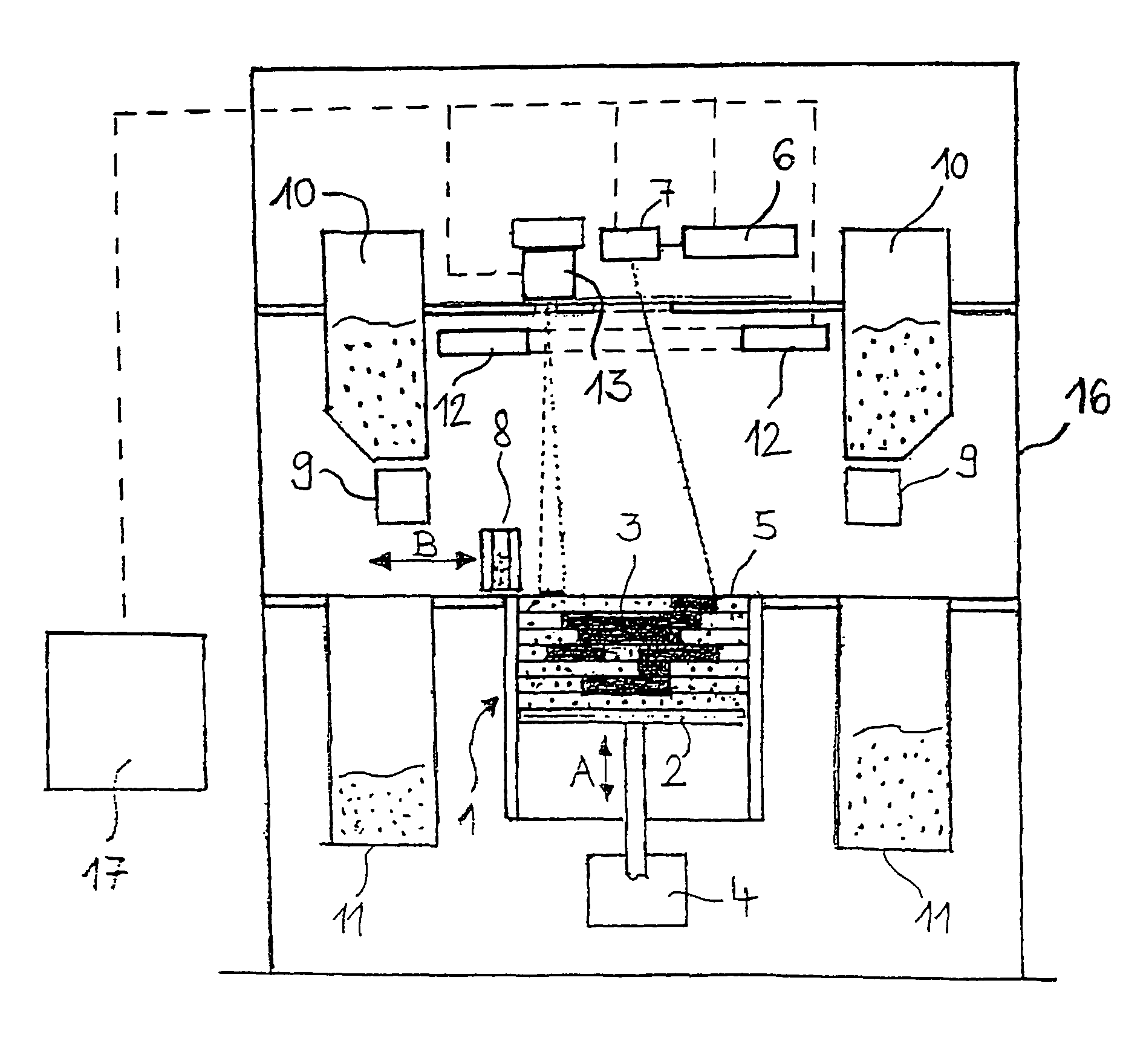Radiant heater for heating the building material in a laser sintering device
a laser sintering device and heating device technology, applied in the direction of domestic heating, drying solid materials, drying machines, etc., can solve the problem of not being able to quickly control or adjust the temperature, and achieve the effect of low thermal inertia, and fast and precise adjustment/control
- Summary
- Abstract
- Description
- Claims
- Application Information
AI Technical Summary
Benefits of technology
Problems solved by technology
Method used
Image
Examples
first embodiment
[0023]FIG. 2 shows the radiant heating.
[0024]The radiant heating 112 according to the first embodiment comprises a resistive element 113 as heat radiating element. The resistive element 113 is formed of a graphite plate (e.g. carbon fiber reinforced graphite plate ®SigraBond of SGL Carbon) having a thermal diffusivity a>1.5·10−4 m2 / s at a temperature of 20° C. and a thickness of d=2.0 mm. It substantially has the shape of a rectangle with a rectangular opening 114 for the laser beam and the optical path of the temperature measuring device being positioned at the center. The resistive element surrounding the rectangular opening is interrrupted at the periphery by means of a gap 115. On both sides of the gap a contact 116 and 116′, respectively, which in each case is designed as a copper bar, is attached to the resistive element. A controllable voltage supply 117 that is designed for high currents (approximately 20-40 A at a voltage of 30-60 V) is connected to the contacts 116, 116′. ...
second embodiment
[0031]In FIG. 4 a cross-section of the inventive radiant heating is shown.
[0032]In the radiant heating 212 according to the second embodiment a graphite foil 213 (e.g. ®Sigraflex graphite foil from SGL Carbon) is provided as heat radiating element, which has a thermal diffusivity of a=2.14·10−4 m2 / s at a temperature of 20° C. in a direction parallel to the foil and which has a thickness of d=0.5 mm.
[0033]In order to achieve a high emission coefficient the graphite foil 213 is treated with a blackbody spray. It is pressed against a heating wire 215 by means of thin rigid profiled bars 214, so that a good thermal contact is formed between the heating wire 215 and the graphite foil 213. Moreover, the profiled bars contribute to the mechanical stability of the graphite foil.
[0034]At the side of the heating wire 215 facing away from the graphite foil a first insulation 216 is provided, which has a bottom side that is reflective for heat radiation. A material having high mechanical stabil...
third embodiment
[0037]FIG. 5 shows the inventive radiant heating.
[0038]As it was the case in the second embodiment, in the radiant heating 312 according to the third embodiment a graphite foil 313 is provided as heat radiating element. However, differing from the second embodiment, this graphite foil is not heated by a heating wire, but by IR heat radiators 314, which are positioned at a distance on one side of the graphite foil. Laterally and at the side facing away from the graphite foil the IR heat radiators 314 are surrounded by an insulating shell 315 with a distance inbetween. The insulating shell is characterized in that it is reflective for heat radiation towards the side of the IR radiators and that it has preferably low heat conductivity. Like the heat insulation consisting of the first and second insulation in the second embodiment, the insulating shell 315 may have a multi-layer construction in order to combine a mechanical stability with good insulating characteristics at the same time...
PUM
| Property | Measurement | Unit |
|---|---|---|
| temperature | aaaaa | aaaaa |
| thickness | aaaaa | aaaaa |
| temperatures | aaaaa | aaaaa |
Abstract
Description
Claims
Application Information
 Login to View More
Login to View More - R&D
- Intellectual Property
- Life Sciences
- Materials
- Tech Scout
- Unparalleled Data Quality
- Higher Quality Content
- 60% Fewer Hallucinations
Browse by: Latest US Patents, China's latest patents, Technical Efficacy Thesaurus, Application Domain, Technology Topic, Popular Technical Reports.
© 2025 PatSnap. All rights reserved.Legal|Privacy policy|Modern Slavery Act Transparency Statement|Sitemap|About US| Contact US: help@patsnap.com



